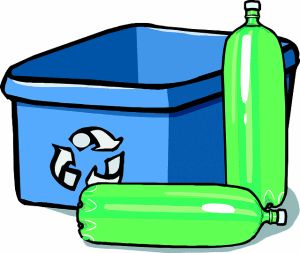We generate a lot of rubbish daily and discard or toss it away. To name a few, there are a slew of commonplace consumables like vegetable and fruit peels, empty cartons, and spent tea leaves that may be thrown out in the kitchen. Bacteria and other decomposers can quickly break down many of these items, such as paper, vegetable and fruit peels.
There are mainly biodegradable and non-biodegradable materials. Biodegradable compounds are those that can be broken down by the activity of microorganisms. Non-biodegradable substances include plastics, metal cans, and insecticides that can’t be broken down by natural processes.
Technology has improved the quality of living and facilitated the emergence of a new way of life. This has an unpredictable effect on the ecology and various forms of life on the planet. For instance, plastic water bottles are handy to use and carry, but their disposal is a challenge for nature.
There are several types of garbage, both biodegradable and non-biodegradable. As a result, trash must be classified and properly disposed of. Biodegradable and non-biodegradable waste products are available. Hazards and risks related to garbage disposal may be readily avoided by understanding the many types of waste.
Biodegradable waste- an introduction!
A biodegradable material or substance decomposes readily in bacteria or other natural creatures and does not contribute to pollution.
Biodegradable wastes are those that are and can be readily decomposed by natural causes such as microorganisms (e.g. bacteria, fungus, and a few others), as well as abiotic components such as temperature, ultraviolet light, and oxygen. Kitchen wastes, food ingredients, and other natural wastes are a few examples of such wastes. Together, microorganisms and other abiotic components degrade complex chemicals into basic organic stuff that eventually suspends and disperses into the soil. The whole procedure is normal and might occur quickly or slowly. As a result, the environmental impact and danger posed by biodegradable wastes are negligible.
Biodegradable waste is garbage produced naturally by plants or animals and maybe decomposed by other living creatures.
Biodegradable waste can be usually found in municipal solid waste such as green waste, food waste, paper waste, and biodegradable plastics. Several sources include human waste, sewage, and slaughterhouse waste.
Biodegradable materials
However, the massive dumping of rubbish will eventually exacerbate certain hazards to life. To avoid this, some individuals engage in a process called composting. Composting involves dumping biodegradable garbage into a large hole and covering it for an extended period of time. Microbes will degrade the material, and it will be utilised as compost for horticulture purposes. It will result in a decrease in the amount of garbage disposed of in landfills.
Non- Biodegradable waste- an introduction!
Non-biodegradable wastes are those that cannot be decomposed or degraded biologically. The majority of them include inorganic trash that is not biodegradable.
A non-biodegradable substance cannot be broken down by natural organisms and hence contributes to pollution.
In contrast to biodegradable trash, non-biodegradable wastes are difficult to manage. Non-biodegradable wastes are those that are incapable of being decomposed or destroyed naturally. They survive on the planet for thousands of years without degrading or decomposing. As a result, the threat they pose is much more deadly. Plastic is a good example since it is often utilised in practically every field.
To ensure the durability of these polymers, higher-quality plastics are being used. It increases their temperature resistance and toughness even after usage. Other examples include cans, metals, and agricultural and industrial chemicals. They are the primary contributors to air, water, soil pollution, and illnesses like cancer.
Non-biodegradable wastes are not Eco-friendly. They must be replaced or substituted. As part of the emergence of alternatives, scientists have proposed several novel concepts, such as biodegradable polymers. They mixed certain biodegradable elements with polymers to create products that degrade readily and quickly. However, this is a very expensive operation. Non-biodegradable wastes that may be recycled and reused are called “Recyclable waste,” whereas those that cannot be recycled are referred to as “Non-recyclable trash.”
Effect of waste on our natural environment!
Waste amounts are routinely cultivated in every country on Earth. Annually, billions of tonnes of trash are generated. These wastes result from activity in our homes, companies, and industries, and their massive disposal creates a significant environmental concern. Agriculture, biomass, municipal and industrial solid wastes contribute to large-scale land and water pollution. Garbage generation degrades resources. It increases the environmental costs associated with waste collection, treatment, and disposal. Landfill and incineration have major environmental impacts due to greenhouse gas emissions (methane and carbon dioxide), transboundary migration of organic micropollutants (dioxins and furans), and volatile heavy metals. Waste management issues date back to the dawn of humanity.
Humans quickly recognised that waste is a possible cause of sickness, disease, and infection, and hence disposed of their waste in a completely biological manner. The first municipal landfill was established outside of ancient Greece about 500 BC when rules required rubbish to be placed at least a mile from city limits and covered with earth. Until the industrial revolution, most of civilisation’s waste was organic, which means it decomposes or degrades organically. Later on, primarily due to industry, urbanisation, and social growth, the quantity of garbage produced increased dramatically.
Biodegradable and Non-biodegradable Materials
Biodegradable |
Non-Biodegradable |
| Biodegradable waste is not accumulated but is used up in a short time | Non-Biodegradable waste often accumulate |
| The degradation process in Biodegradable waste is rapid | The degradation process in Non-Biodegradable waste is slow |
| Biodegradable waste is decomposed and degraded by microbes | Microbes cannot decompose Non-Biodegradable waste |
| Biodegradable waste is used to produce energy manure, compost and biogas | Non-Biodegradable waste can be separated and recycled, but the process is very expensive |
| Biodegradable waste become part of biogeochemical cycles and give back rapid turnover | Most of the Non-Biodegradable waste never enter into biogeochemical cycles, very slow and toxic |
Conclusion:
Whether biodegradable or not, they endanger human life and devastate other creatures and their habitat. As a result, wastes must be properly treated. It is not just the government’s obligation but also the responsibility of every person. The three Rs—Recycle, Reuse, and Reduce—are the easiest activities that any individual can do to help. This may also result in energy and other resource savings. Additionally, segregate biodegradable and non-biodegradable waste at home and dispose of them separately.




